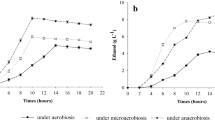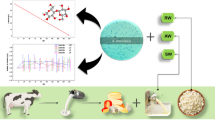Abstract
Fermentative hydrogen production is strongly affected by pH. In order to maximize hydrogen production and substrate consumption in Escherichia coli ΔhycA, ΔlacI (WDHL) cheese whey fermentation, the influence of pH control at values of 5.5, 6, and 6.5 was studied in batch stirred-tank bioreactors. From the conditions evaluated, pH 6.5 was the best condition, at which the highest cumulative hydrogen production and yield (1.78 mol H2/mol lactose) were obtained. Moreover, at this pH, all carbohydrates from the cheese whey were consumed, and a mix of ethanol and organic acids, mainly lactate, were produced from glucose, whereas galactose yielded acetate, ethanol, and succinate. Operating the reactor at pH 5.5 resulted in the highest maximum specific production rate, but smaller hydrogen yield because only glucose was metabolized and galactose was accumulated. At pH 6, not all cheese whey carbohydrates were consumed, and it was not favorable for hydrogen production. Lactose consumption and growth kinetics were not affected by the pH. The results show the importance of controlling pH to maximize hydrogen production and substrate consumption using cheese whey as substrate.





Similar content being viewed by others
References
Kapdan, I. K., & Kargi, F. (2006). Bio-hydrogen production from waste materials. Enzyme and Microbial Technology, 38, 569–582.
Claassen, P. A. M., van Lier, J. B., Lopez Contreras, A. M., et al. (1999). Utilisation of biomass for the supply of energy carriers. Applied Microbiology and Biotechnology, 52, 741–755.
Davila-Vazquez, G., Arriaga, S., Alatriste-Mondragón, F., de León-Rodríguez, A., Rosales-Colunga, L. M., & Razo-Flores, E. (2008). Fermentative biohydrogen production: trends and perspectives. Reviews in Environmental Science and Biotechnology, 7, 27–45.
Kotay, S. M., & Das, D. (2008). Biohydrogen as a renewable energy resource—prospects and potentials. International Journal of Hydrogen Energy, 33, 258–263.
Manish, S., & Banerjee, R. (2008). Comparison of biohydrogen production processes. International Journal of Hydrogen Energy, 33, 279–286.
Nath, K., & Das, D. (2004). Improvement of fermentative hydrogen production: various approaches. Applied Microbiology and Biotechnology, 65, 520–529.
Vardar-Schara, G., Maeda, T., & Wood, T. K. (2008). Metabolically engineered bacteria for producing hydrogen via fermentation. Microbial Biotechnology, 1, 107–125.
Siso, M. I. G. (1996). The biotechnological utilization of cheese whey: a review. Bioresource Technology, 57, 1–11.
Prazeres, A. R., Carvalho, F., & Rivas, J. (2012). Cheese whey management: a review. Journal of Environmental Management, 110, 48–68.
Gannoun, H., Khelifi, E., Bouallagui, H., Touhami, Y., & Hamdi, M. (2008). Ecological clarification of cheese whey prior to anaerobic digestion in upflow anaerobic filter. Bioresource Technology, 99, 6105–6111.
Benhassan, R. M., & Ghaly, A. E. (1994). Continuous propagation of Kluyveromyces fragilis in cheese whey for pollution potential reduction. Applied Biochemistry and Biotechnology, 47, 89–105.
Koutinas, A. A., Papapostolou, H., Dimitrellou, D., et al. (2009). Whey valorisation: a complete and novel technology development for dairy industry starter culture production. Bioresource Technology, 100, 3734–3739.
Panesar, P. S., Kennedy, J. F., Gandhi, D. N., & Bunko, K. (2007). Bioutilisation of whey for lactic acid production. Food Chemistry, 105, 1–14.
Panesar, P. S., & Kennedy, J. F. (2012). Biotechnological approaches for the value addition of whey. Critical Reviews in Biotechnology, 0, 1–22.
de León-Rodríguez, A., Rivera-Pastrana, D., Medina-Rivero, E., et al. (2006). Production of penicillin acylase by a recombinant Escherichia coli using cheese whey as substrate and inducer. Biomolecular Engineering, 23, 299–305.
Castelló, E., García y Santos, C., Iglesias, T., et al. (2009). Feasibility of biohydrogen production from cheese whey using a UASB reactor: links between microbial community and reactor performance. International Journal of Hydrogen Energy, 34, 5674–5682.
Venetsaneas, N., Antonopoulou, G., Stamatelatou, K., Kornaros, M., & Lyberatos, G. (2009). Using cheese whey for hydrogen and methane generation in a two-stage continuous process with alternative pH controlling approaches. Bioresource Technology, 100, 3713–3717.
Hallenbeck, P. C. (2005). Fundamentals of the fermentative production of hydrogen. Water Science and Technology, 52, 21–29.
Rosales-Colunga, L. M., Razo-Flores, E., Ordoñez, L. G., Alatriste-Mondragón, F., & de León-Rodríguez, A. (2010). Hydrogen production by Escherichia coli ΔhycA ΔlacI using cheese whey as substrate. International Journal of Hydrogen Energy, 35, 491–499.
Ferchichi, M., Crabbe, E., Gil, G. H., Hintz, W., & Almadidy, A. (2005). Influence of initial pH on hydrogen production from cheese whey. Journal of Biotechnology, 120, 402–409.
Nath, K., Kumar, A., & Das, D. (2006). Effect of some environmental parameters on fermentative hydrogen production by Enterobacter cloacae DM11. Canadian Journal of Microbiology, 52, 525–532.
Davila-Vazquez, G., Alatriste-Mondragón, F., de León-Rodríguez, A., & Razo-Flores, E. (2008). Fermentative hydrogen production in batch experiments using lactose, cheese whey and glucose: influence of initial substrate concentration and pH. International Journal of Hydrogen Energy, 33, 4989–4997.
Li, Z., Wang, H., Tang, Z., Wang, X., & Bai, J. (2008). Effects of pH value and substrate concentration on hydrogen production from the anaerobic fermentation of glucose. International Journal of Hydrogen Energy, 33, 7413–7418.
Calli, B., Schoenmaekers, K., Vanbroekhoven, K., & Diels, L. (2008). Dark fermentative H2 production from xylose and lactose—effects of on-line pH control. International Journal of Hydrogen Energy, 33, 522–530.
De Leon-Rodriguez, A., Gonzalez-Hernandez, L., Barba de la Rosa, A. P., Escalante-Minakata, P., & Lopez, M. G. (2006). Characterization of volatile compounds of Mezcal, an ethnic alcoholic beverage obtained from Agave salmiana. Journal of Agricultural and Food Chemistry, 54, 1337–1341.
Ghosh, D., & Hallenbeck, P. C. (2009). Fermentative hydrogen yields from different sugars by batch cultures of metabolically engineered Escherichia coli DJT135. International Journal of Hydrogen Energy, 34, 7979–7982.
Yoshida, A., Nishimura, T., Kawaguchi, H., Inui, M., & Yukawa, H. (2005). Enhanced hydrogen production from formic acid by formate hydrogen lyase-overexpressing Escherichia coli strains. Applied and Environmental Microbiology, 71, 6762–6768.
Penfold, D. W., Forster, C. F., & Macaskie, L. E. (2003). Increased hydrogen production by Escherichia coli strain HD701 in comparison with the wild-type parent strain MC4100. Enzyme and Microbial Technology, 33, 185–189.
Penfold, D. W., Sargent, F., & Macaskie, L. E. (2006). Inactivation of the Escherichia coli K-12 twin-arginine translocation system promotes increased hydrogen production. FEMS Microbiology Letters, 262, 135–137.
Redwood, M. D., Mikheenko, I. P., Sargent, F., & Macaskie, L. E. (2008). Dissecting the roles of Escherichia coli hydrogenases in biohydrogen production. FEMS Microbiology Letters, 278, 48–55.
Blankenhorn, D., Phillips, J., & Slonczewski, J. L. (1999). Acid- and base-induced proteins during aerobic and anaerobic growth of Escherichia coli revealed by two-dimensional gel electrophoresis. Journal of Bacteriology, 181, 2209–2216.
Stancik, L. M., Stancik, D. M., Schmidt, B., Barnhart, D. M., Yoncheva, Y. N., & Slonczewski, J. L. (2002). pH-dependent expression of periplasmic proteins and amino acid catabolism in Escherichia coli. Journal of Bacteriology, 184, 4246–4258.
Yohannes, E., Barnhart, D. M., & Slonczewski, J. L. (2004). pH-dependent catabolic protein expression during anaerobic growth of Escherichia coli K-12. Journal of Bacteriology, 186, 192–199.
Rosales-Colunga, L. M., González García, R., & De León Rodríguez, A. (2010). Estimation of hydrogen production in genetically modified E. coli fermentations using an artificial neural network. International Journal of Hydrogen Energy, 35, 13186–13192.
Clark, D. P. (1989). The fermentation pathways of Escherichia coli. FEMS Microbiology Letters, 63, 223–234.
van Ginkel, S., & Logan, B. E. (2005). Inhibition of biohydrogen production by undissociated acetic and butyric acids. Environmental Science and Technology, 39, 9351–9356.
Jones, D. T., & Woods, D. R. (1986). Acetone-butanol fermentation revisited. Microbiological Reviews, 50, 484–524.
Zhang, H., Boghigian, B. A., & Pfeifer, B. A. (2010). Investigating the role of native propionyl-CoA and methylmalonyl-CoA metabolism on heterologous polyketide production in Escherichia coli. Biotechnology and Bioengineering, 105, 567–573.
Redwood, M. D., Orozco, R. L., Majewski, A. J., & Macaskie, L. E. (2012). Electro-extractive fermentation for efficient biohydrogen production. Bioresource Technology, 107, 166–174.
Jian, J., Zhang, S.-Q., Shi, Z.-Y., Wang, W., Chen, G.-Q., & Wu, Q. (2010). Production of polyhydroxyalkanoates by Escherichia coli mutants with defected mixed acid fermentation pathways. Applied Microbiology and Biotechnology, 87, 2247–2256.
Leonhartsberger, S., Korsa, I., & Bock, A. (2002). The molecular biology of formate metabolism in enterobacteria. Journal of Molecular Microbiology and Biotechnology, 4, 269–276.
Sawers, R. G. (2005). Formate and its role in hydrogen production in Escherichia coli. Biochemical Society Transactions, 33, 42–46.
Bagramyan, K., Mnatsakanyan, N., Poladian, A., Vassilian, A., & Trchounian, A. (2002). The roles of hydrogenases 3 and 4, and the F0F1-ATPase, in H2 production by Escherichia coli at alkaline and acidic pH. FEBS Letters, 516, 172–178.
Masset, J., Hiligsmann, S., Hamilton, C., Beckers, L., Franck, F., & Thonart, P. (2010). Effect of pH on glucose and starch fermentation in batch and sequenced-batch mode with a recently isolated strain of hydrogen-producing Clostridium butyricum CWBI1009. International Journal of Hydrogen Energy, 35, 3371–3378.
Liu, I. C., Whang, L.-M., Ren, W.-J., & Lin, P.-Y. (2011). The effect of pH on the production of biohydrogen by Clostridia: thermodynamic and metabolic considerations. International Journal of Hydrogen Energy, 36, 439–449.
Acknowledgments
We thank CONACyT for partial funding of this work through SENER grant 150001 and CONACyT-Básicas 178988. L.M. Rosales thanks CONACyT for scholarship number 174494. The authors acknowledge the technical assistance of Leandro G Ordoñez-Acevedo, Dulce Maria Partida Gutiérrez, and Guillermo Vidriales Escobar. We thank Jennifer Eckerly Goss for the English revision.
Author information
Authors and Affiliations
Corresponding authors
Rights and permissions
About this article
Cite this article
Rosales-Colunga, L.M., Alvarado-Cuevas, Z.D., Razo-Flores, E. et al. Maximizing Hydrogen Production and Substrate Consumption by Escherichia coli WDHL in Cheese Whey Fermentation. Appl Biochem Biotechnol 171, 704–715 (2013). https://doi.org/10.1007/s12010-013-0394-9
Received:
Accepted:
Published:
Issue Date:
DOI: https://doi.org/10.1007/s12010-013-0394-9




